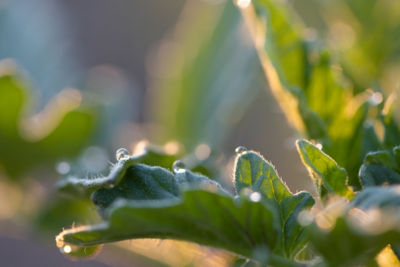Click here to download a PDF version of this spotlight.
» Melons (cantaloupe and muskmelon types) are grown in many regions of the U.S.
» Melons are warm-season plants that require temperatures above 60°F for growth.
» Several indicators of maturity are used to determine when melons are ready for harvest.
GROWING CONDITIONS
Melons are warm-season annuals that are sensitive to freezing temperatures at any growth stage. Melons grow best at temperatures between 85° and 95°F. Growth is slow at temperatures below 60°F, and plants can tolerate temperatures over 104°F.1,2 Light, well-drained soils that have good water-holding capacities are preferred. However, melons are grown successfully in soils with textures that range from sandy to clay loams. The plants need a constant water supply for the fastest growth and best yields, but excessive water application should be avoided, as the roots are susceptible to root diseases in overly wet and poorly aerated conditions.1,2 The soil pH should be between 6.0 and 6.5 for optimum growth.3 Avoid rotations with other cucurbit crops, such as squash, cucumber, and watermelon.4
Melons are grown in both the Eastern and Western regions of the U.S., which have very different climatic conditions. Conditions in the West are typically dry, with most of the water applied as irrigation. Conditions in the Eastern states are typically more humid, and these areas typically receive more rainfall during the growing season. A heavy rainfall just before harvest can result in melons taking up too much water resulting in cracked and ruptured fruit.
The wet and humid conditions in the East are favorable for many foliar diseases caused by fungi and bacteria, and other diseases such as root, and vine diseases caused by oomycete organisms (Pythium, Phytophthora, and downy mildews) and bacterial wilt. The bacterial wilt pathogen overwinters in striped and spotted cucumber beetles, and these beetles spread the disease to melons and other cucurbit crops when they feed on the plants. Some level of control of the cucumber beetles is usually necessary when growing melons in the Eastern region.2,4 Other diseases, such as powdery mildew and Fusarium wilt, occur in both the Eastern and Western regions. In all growing areas, it is important to keep plants healthy and protected from diseases, insect feeding, and weed competition, and to prevent nutrient deficiencies. Half of the sugar content of the fruit is produced in the last week of maturation. Leaf damage and poor plant health at the end of the season can result in lower quality melons with reduced levels of sugar and poor flavor.3,4
PLANTING
Before planting, prepare planting beds so that the bed surface is smooth and free of soil clods and plant debris. Melons can be directseeded or transplanted. Direct-seed melons when soil temperatures are at least 60°F. Melon seeds will not germinate at soil temperatures below 60°F, and the optimal temperature range for germination is 70° to 95°F.3,4 In the Western regions of the country, seedlings for transplanting are typically started in the greenhouse 24 to 40 days before transplanting; 18 to 24 day-old seedlings are often used in mid-summer. Growers in the Eastern U.S. usually transplant 4 to 5 week-old seedlings. Transplanting should take place after any danger of frost has passed.2,4 However, row covers can be used to help protect plants from frost.
In the West, melons are often planted at populations of 5,200 to 6,500 plants per acre. In the East, populations of 2,200 to 4,400 are more typical. Single rows are planted on 5- to 6-foot row centers. In the West, within-row plant spacings of 12- to 24-inches are typical, while in the East 18- to 30-inch spacings are commonly used. Melons can be planted on raised beds with drip irrigation and plastic mulch (plasticulture). Plastic mulches can increase earliness and yield, and black or IRT mulches can help suppress weeds in the planting beds.2,4
 Figure 1. A mature melon should be fully netted from the stem end to the blossom end.
Figure 1. A mature melon should be fully netted from the stem end to the blossom end.
EARLY SEASON GROWTH
Spun-bonded, non-woven row covers can be used as windbreaks and for frost protection, and they can help increase heat unit accumulations resulting in earlier harvests. Row covers can be used for 4 to 8 weeks after transplanting, but they must be removed when plants begin to flower to allow pollination by insects (bees).4 In some areas, melons are planted on the south-facing slopes of raised planting beds (sloped bed culture) to promote earliness through the solar heating of the soil.1
FLOWERING
Melon plants can produce separate male and female flowers on the same plant (monoecious flowering) or flowers that contain both male and female organs in the same flower (perfect flowers). Because of this, melons do not require the use of pollenizer plants to provide pollen. Most of the roundfruited varieties that are commonly grown in the United States produce both male flowers and perfect flowers, a condition known as andromonoecious. Male flowers usually form before female and perfect flowers.4 Melon flowers must be insectpollinated because the pollen is sticky and heavy and is not carried in the wind.4
Honey bees are the main pollinators for melons, and there should be at least one colony of bees per acre (more commonly 1.5 to 2 colonies/acre) during flowering to obtain maximum fruit set. Each flower needs to be visited 10 to 15 times by honey bees to ensure adequate pollination. Bee colony spacing within the field is important, as no flower should be more than 250 yards from a colony. Spacing colonies no more than 175 yards apart is usually recommended. Colonies should be placed in the field just before the appearance of the perfect or female flowers, and hives should be kept in the field for 2 to 3 weeks. The application of insecticides that are harmful to bees should be avoided during the pollination period.1,2,4
HARVESTING
The shelf life of a melon variety’s fruit is used to classify the variety into one of three groups, traditional shelf life (TSL), extended shelf life (ESL), and long shelf life (LSL). The ESL and LSL varieties hold their levels of soluble solids in the field and after harvest. Because of this, the timing for harvesting these varieties is different than the timing used for TSL varieties. Because melon flowers are pollinated over a period of weeks, the fruit do not all mature at the same time. TSL melons are harvested 8 to 10 times over a period of 10 to 14 days. Fruit can be harvested every other day at the beginning of the harvest season and every day during peak harvest.1,3,4 Because ESL and LSL melons have longer shelf lives, they can be held in the field and harvested in fewer passes. ESL and LSL varieties are usually harvested in 2 to 4 passes.
The time of melon harvest is determined by fruit maturity, not by fruit size. Melons quality and flavor are best if the fruit are harvested when they reach full maturity. Mature melonscontinue to ripen after they have been harvested, but the soluable solids content of the fruit does not increase after harvest.3,5 Factors used to determine maturity include the level of netting on the fruit (Figure 1), the background color, and the soluble solids content (average Brix value). The fruit of TSL and ESL melons cleanly separate from the peduncle (fruit stem) with a slight tug when they reach maturity, which is called the full-slip stage. At this stage, the fruit has formed a complete abscission layer, and the stems pull away without leaving any stem tissue attached to the fruit.1,2,3 At full-slip, melons should be firm and well netted, and the skin of the fruit becomes slightly yellow under the netting, although the skin of some varieties will retain a greenish cast when mature (Figure 1).
Most LSL melons are non-slip, meaning that the fruit do not easily separate from the stem. These varieties have to be cut from the stem at harvest. With many of these varieties, the background skin color stays green at maturity, so other methods of determining maturity must be used. One method is to look at the amount of netting running from the fruit up onto the stem (Figure 2). The withering of the leaf nearest the fruit stem attachment is another indication of maturity.
 Figure 2. As fruit begin to mature, netting starts to run up the stem (A). At full maturity, the netting on the stem will be well developed (B).
Figure 2. As fruit begin to mature, netting starts to run up the stem (A). At full maturity, the netting on the stem will be well developed (B).
For good eating quality, the soluble solids level of the fruit should have an average Brix value of 12° (12% soluble solids) at the time of harvest. Fruit should be free of scrapes, cuts, and bruises, and have good internal quality.5,6 TSL melons grown for local market sales often have soluble solid concentrations of 14%. These melons typically have a shortershelf life and may not be suitable for long-distance shipping.4
SOURCES
1 Hartz, T., Cantwell, M., Mickler, J., Mueller, S., Stoddard, S., and Turini, T. 2008. Cantaloupe production in California. University of California ANR Publication 7218.
2 Harper, J. Kime, L., Orzolek, M., and Bogash, S. 2006. Cantaloupe production. Penn State Extension. https://extension.psu.edu/cantaloupe-production.
3 2017. Cantaloupe and specialty melons. University of Georgia Extension. Bulletin 1179.
4 Oregon Vegetables. 2010. Melons: cantaloupe, muskmelon, honeydew, crenshaw, casaba, etc. Oregon State University. https://horticulture.oregonstate.edu/oregon-vegetables/melonscantaloupe-muskmelon-honeydew-crenshaw-casaba-etc-0.
5 Suslow, T., Cantwell, M., and Mitchell, J. 1997. Cantaloupe: Recommendations for maintaining postharvest quality. http://postharvest.ucdavis.edu/Commodity_Resources/Fact_Sheets/Datastores/Fruit_English/?uid=14&ds=798.
6 United States standards for grades of cantaloups. Effective March 10, 2008.
https://www.ams.usda.gov/grades-standards/cantaloup-grades-and-standards.
Websites verified 4/10/2020
ADDITIONAL INFORMATION
For additional agronomic information, please contact your local seed
representative.
Performance may vary from location to location and from year to year, as local growing, soil and weather conditions may vary. Growers should evaluate data from multiple locations and years whenever possible and should consider the impacts of these conditions on the grower’s fields. The recommendations in this article are based upon information obtained from the cited sources and should be used as a quick reference for information about melon production. The content of this article should not be substituted for the professional opinion of a producer, grower, agronomist, pathologist and similar professional dealing with this specific crop.
BAYER GROUP DOES NOT WARRANT THE ACCURACY OF ANY INFORMATION OR TECHNICAL ADVICE PROVIDED HEREIN AND DISCLAIMS ALL LIABILITY FOR ANY CLAIM INVOLVING SUCH INFORMATION OR ADVICE.
9060_SE_S1 Published 05-26-2020
Bayer, Bayer Cross Design, and Seminis® are registered trademarks of Bayer Group. All other trademarks are property of their respective owners. © 2020 Bayer Group. All rights reserved.



